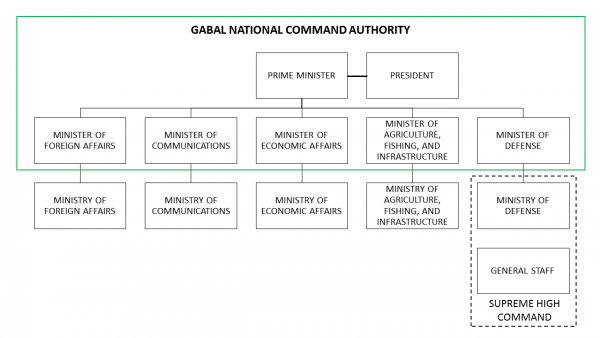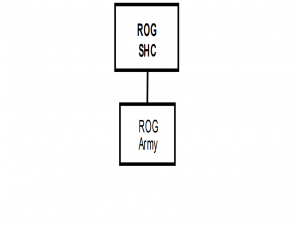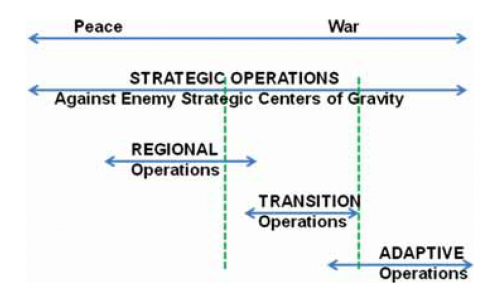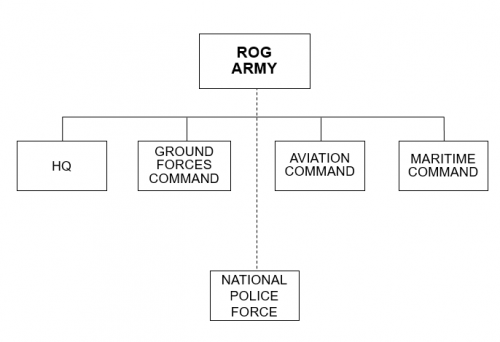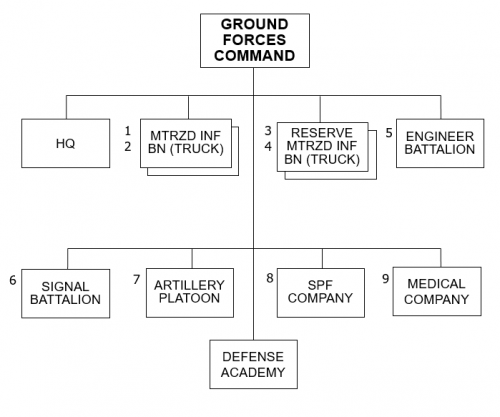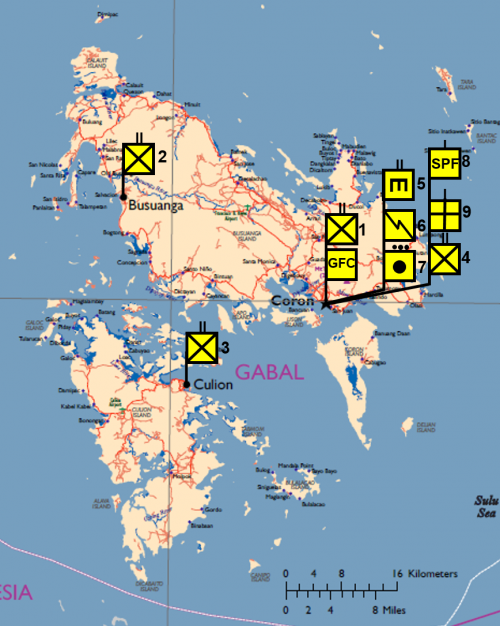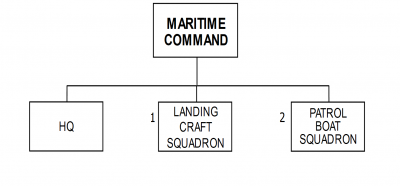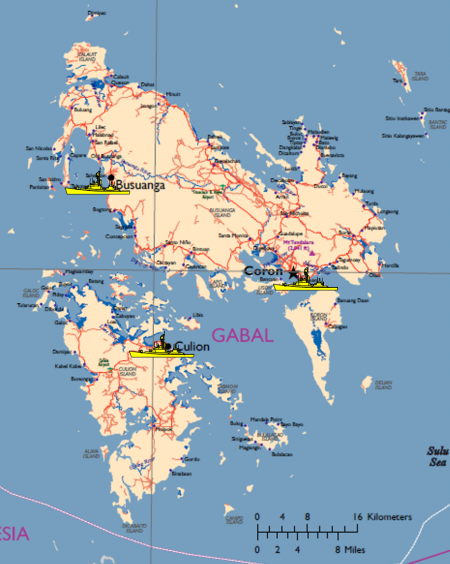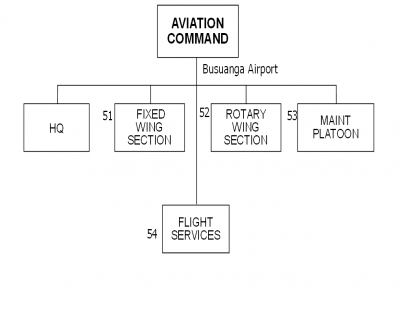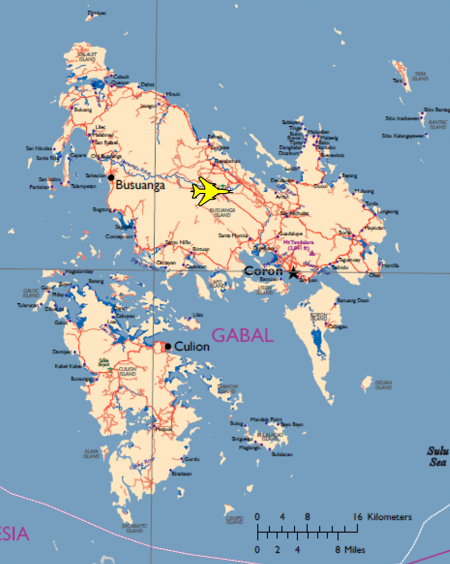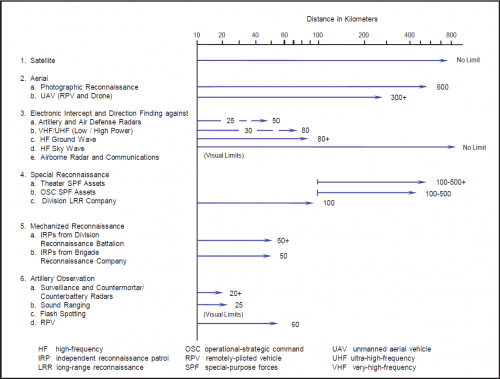Military: Gabal
DATE Pacific > Gabal > Military: Gabal ←You are here
Contents
- 1 Military Overview
- 2 Military Forces
- 3 National Command Authority
- 4 National Strategic Goals
- 5 Military Forces Overview
- 6 Land Forces/Army Overview
- 7 Maritime Forces Overview
- 8 Air Forces Overview
- 9 Paramilitary Forces
- 10 Kumpulan Crime Organization
- 11 Military Functions Overview
- 12 Research and Development Goals
- 13 Special Considerations
Military Overview
The Republic of Gabal’s Army (RoGA) serves mainly as a military force for the MoI to protect and preserve the natural and mineral wealth of the Republic of Gabal. Although charge with the defense of Gabal under the MoD, it is mainly used to protect Gabal’s coastline and prevent illegal fishing activities in the country’s territorial waters. Its public presence is more symbolic than functional. It projects the attitude of Gabal’s independence from its neighbors more than it serves as any true fighting force. Its small size limits its offensive capabilities and is not seen by its neighboring countries s as threat. The Gabal military also lacks the ability to defend itself against any major external threat.
Military Forces
The Gabal military (RoGA) is organized under the Gabal Supreme High Command (SHC), made up of members of the Ministry of Defense (MoD) and the General Staff. RoGA (subordinate to the SHC), consists of predominately ground forces under the Land Command, an Aviation Command, and a Maritime Command. If required the National Police can be federalized and fall under the control of SHC. Habitually, the Aviation and Maritime Commands are subordinate to Land Command due to their small size, and their inability to command and control large military operations. Many of the army infantry battalions are cadre units and would only be filled from the reserves in times of a national emergency. The aviation elements consist primarily of transportation helicopters for the military and political VIPs. The navy, in reality, is only a coast guard tasked with the mission to stop illegal fishing within Gabal’s territorial waters.
National Command Authority
NCA Structure
While Gabal’s elected president occupies the county’s executive position, most of the government’s power resides in the Office of the Prime Minister (PM) and his cabinet. In the diagram above, certain cabinet ministers are part of the National Command Authority (NCA). The Gabal NCA exercises overall control of the application of all instruments of national power to plan and carry out the country’s national security strategy. The Gabal NCA is made up of the Ministers of: Foreign Affairs, Communications, Economic Affairs, Agriculture, Fishing, and Infrastructure, and Defense, along with the Prime Minister, who chairs the NCA.
The PM oversees the NCA’s planning efforts. With the president, the PM serves as the director responsible to integrate all the instruments of national power under one cohesive national security strategy. The NCA coordinates the plans and actions of all Gabal’s ministries, but particularly those associated with the instruments of national power. (See TC 7-100.2: Opposing Force Tactics, Chapter 1, Strategic and Operational Framework.)
Strategic Operational Framework
The NCA exercises command and control (C2) of their Army via the Ministry of Defense (MoD) and a General Staff drawn from all the service components. In peacetime, the MoD and General Staff operate closely but separately. The MoD assumes the responsibility for policy, acquisitions, and financing the Armed Forces. The General Staff promulgates policy and supervises the service components, while its functional directorates assume responsibility for key aspects of defense planning. In wartime, the MoD and General Staff merge to function as a unified headquarters.
The Gabal General Staff operates an administrative force structure (AFS) that manages its military forces in peacetime. This AFS contains the aggregate of various military headquarters, facilities, and installations designed to man, train, and equip the forces. In peacetime, the various components group their forces as separate units for administrative purposes. The Gabal military arranges their forces administratively under geographical commands. Typically, these administrative groupings differ from the country’s go-to-war (fighting) force structure. Other parts of the AFS consist of assets centrally controlled at the national level. (See FM 7-100.4 Opposing Force Organization Guide: Chapter 3, Task Organizing.)
Supreme High Command (SHC) Structure
Due to the small size of the RoG military, all forces served under the RoG Army (RoGA). The chain of command runs from the head of the government through the SHC composed of the MoD and the General Staff. The SHC controls the RoGA through a single command channel.
National Strategic Goals
Gabal derives its strategic goals from its long and fierce history of independence from neighboring countries dating back to before contact with Western civilization. While Gabal became reluctantly involved in World War II due to its strategic position and mineral wealth, it reasserted its independence after the ouster of its occupiers. The maintenance of Gabal’s sovereignty and the suppression of any small insurgent groups that may pop up forms their strategic vision.
- Project a convincing defense to discourage attacks against Gabal's sovereignty.
- Work with friendly countries to protect Gabal from external threats.
- Prevent illegal fishing and protect coastal resources within the country's territorial waters.
- Control economic expansion, primarily through the tourist trade, to improve the people's lives.
- Produce or procure sufficient food to feed the population of Gabal.
Implementing National Security Goals
Most countries in the region adapted similar strategies to achieve their national goals except for Gabal. Its small size and limited capabilities severely restricts its ability to establish a conventional security strategy. For most countries, strategic operations remain a continuous process not limited to wartime or preparation for war. Once war begins, strategic operations continue during regional, transition, and adaptive operations and complement those operations. Each of the latter three types of operations occurs only during war and only under certain conditions. Transition operations can overlap regional and adaptive operations.
The four types of operations that other countries can conduct include:
- Strategic operations use all instruments of power in peace and war to achieve a country’s national security strategy goals through attacks against the enemy’s strategic centers of gravity.
- Regional operations include conventional, force-on-force military operations against overmatched opponents, such as regional adversaries and internal threats.
- Transition operations bridge the gap between regional and adaptive operations and contain some elements of both. The country continues to pursue its regional goals while dealing with developing outside intervention that has the potential to overmatch its military.
- Adaptive operations preserve the country’s power and apply it in adaptive ways against opponents that overmatch the country’s military.
In pursuit of its national security strategy, Gabal must modify the operations that larger and more prosperous countries can conduct. Gabal must work with other countries that will assist them to obtain their national goals. Gabal does not have the capacity to conduct strategic or regional operations on its own. If necessary, Gabal will conduct transition operations as other countries would in pursuing its goals. If invaded, Gabal’s terrain would likely make it possible for its military and people to pursue adaptive operations to harass the invaders.
National Security Strategy
It is highly unlikely that Gabal will resort to armed conflict to achieve its desired end state as its military possesses an extremely limited offensive capability. Strategic operations, however, continue even if a particular regional threat or opportunity causes Gabal to undertake “regional operations”. Gabal could only respond to such a threat with the assistance of outside military aid.
Although commonly referred to as “operations,” each of these is a course of action is actually a subcategory of strategy. Each course of action aggregates the effects of the tactical, operational, and strategic actions in coordination with the application of instruments of national power to achieve a country’s strategic goals. The types of operations employed at a given time will depend on the types of threats, opportunities, and other conditions present.
A typically national strategy starts with actions directed towards a regional opponent that a government has overmatch in the instruments of national power including military capability. As the smallest country in the region with minimal offensive capability, Gabal could never achieve military superiority against any opponent. Preferably, Gabal will attempt to achieve its ends without armed conflict by working with other countries that would help them obtain their strategic goals. Gabal will attempt to achieve their desired goal through pressure applied by nonmilitary instruments of power through economic and defense treaties with other countries. These actions fall under the general framework of “strategic operations.”
Military Forces Overview
Gabalian military strategy revolves around the prevention of illegal fishing in their territorial waters and the positive economic relationship the country has with many nations including the US, Olvana, and Donovia. Based on the country’s history with the Western powers and their status of a member of the United Nations (UN), Gabal expects that other countries will come to their defense if invaded. Due to the country’s small size and an active military of 5,600 personnel, all of Gabal’s military plans are defensive in nature. Military expenditures account for 7.81% of overall GDP, mostly for military wages.
Land Forces/Army Overview
The primary mission of the RoGA-GFC, commonly referred to as Ground Forces Command or GFC, is to defend the sovereignty of Gabal. With approximately 4,400 volunteer soldiers, the GFC is the largest command in the RoGA. The GFC primarily is an independent brigade with two active motorized infantry battalions, two reserve motorized infantry battalions, an engineer battalion, signals battalion artillery platoon, medical company and a special purpose forces (SPF) company. Of its 4,400 soldiers approximately 2,500 are reservists. The GFC cannot form brigade tactical groups (BTG) or division tactical groups (DTG) like other armies. However, if the political and military environment allow, it could become part of a BTG or DTG of some other country. (See TC 7-100.2: Opposing Force Tactics, Chapter 2, Command and Control.)
Gabalian military strategy revolves around the prevention of illegal fishing in their territorial waters and the positive economic relationship the country has with many nations including the US, Olvana, and Donovia. Based on the country’s history with the Western powers and their status of a member of the United Nations (UN), Gabal expects that other countries will come to their defense if invaded. Due to the country’s small size and an active military of 5,600 personnel, all of Gabal’s military plans are defensive in nature. Military expenditures account for 7.81% of overall GDP, mostly for military wages.
The majority of the army is located on bases in the vicinity of the city of the Captial, Coron. The exceptions are one active duty infantry battalion that is stationed at Busuanga and a reserve infantry battalion at Culion.
The GFC is the land component of the RoG Army (RoGA). When task organized for combat operations the, the GFC will mission each of the four infantry brigades and assign supporting or command relationships to its engineer battalion, signal battalion, artillery platoon, special purpose forces company and its medical company. During times of national disasters such as earthquakes and typhoons the government often uses the engineer company for reconstruction. Although well trained by RoGA standards, the Special Operations Company also supports the MoI and MoJ effort in anti-terrorist operations. The GFC artillery platoon provides limited general support to maneuver battalions. Until it replaces its M101 howitzers with a more modern and lethal system, its main purpose is ceremonial at best.
Land Forces/Army Size and Structure
See diagram to the left for the RoG Army Ground Forces structure.
Land Forces/Army Forces Distribution Map
See the map to the left to see the locations of the units that compose the RoG Army Ground Forces. Many of the units are stationed near the capitol city.Ground Forces Command
Under the command of the brigade sized GFC, the infantry battalion is primary maneuver unit. Organic to the battalion is a: mortar platoon, reconnaissance platoon, anti-tank guided Missile (ATGM) platoon, automatic grenade launcher (AGL) platoon heavy, man portable air defense system (MANPADS), signal platoon, transport platoon, and a support platoon. Other capabilities within the GFC that is an engineer battalion, signal battalion. When employed, task organized in support of the battalions is an engineer company, an artillery platoon, which is composed primarily of a ceremonial gun platoon. There is an engineer company that the government often uses for reconstruction after natural disasters such as earthquakes and typhoons. The Special Operations Company focuses on anti-terrorist operations, but still needs significant training to meet international standards.
GFC Reserve
There are about 1,765 reservists in the Gabal ground forces about 40% of total ground forces. After completing their required active duty, any soldier leaving active duty honorably must serve in the reserves until the age of 45. If desired, a reservist can continue to serve until the age of 55 as long as they meet the required medical standards. The reservists must serve three weeks of active duty training each year. For the soldiers, this takes place usually in one stretch of time augmenting the active duty personnel in their jobs
The Gabal reserve force is not organized into separate reserve units individuals are assigned to standing army units. Once assigned to one of the two reserve infantry battalions that operate under a cadre of active duty leaders, the soldier will normally remain in that battalion for continuity purposes. Each year, the reservists must serve for three weeks of duty in their assigned unit. Except for the infantry, this training is scattered throughout the year so the other units (combat support and combat service support) have additional personnel at all times. Only two of the four infantry battalions in the infantry brigade are fully manned with the other two in cadre status. The active duty infantry battalions are only trained to a very high standard in individual and squad level jungle operations. Every six months, one of the cadre infantry battalions comes together for three weeks of intense training. Active duty infantry officers and non-commissioned officers rotate on a regular basis between the single complete active duty battalion and the cadre reserve battalions
Every six months, one of the battalions meets for their three weeks of annual training and that unit becomes the “ready battalion” or the first infantry unit available after the two active duty battalions until the next battalion completes its annual training cycle. This “ready battalion” is sometimes activated for natural disasters to supplement the active duty engineer units. For those not in the infantry, the reservists normally return to their previous active duty unit to augment the active duty personnel. The training for the non-infantry personnel is staggered throughout the year so some of the reservists are often on duty at almost all times.
Army National Guard
Gabal has no Army national guard units.
Land Forces/Army Doctrine and Tactics
Due to the proximity to North and South Torbia and their historical relationship with Western powers, Gabal tactics are a mixture of what works best in their island jungles. For the most part, Gabal tactics are those found in TC 7-100.2. Gabal has sent small elements, company size or smaller, on UN missions to Africa and other places. In addition to the exposure to other professional armies that continue to increase the military’s proficiency, this provides a source of income for Gabal. The Gabalian government keeps the difference between what the UN pays for a soldier and what the military pays its soldiers.
Land Forces/Army Training and Readiness
Gabal relies on a strictly volunteer military force. Citizens can join at age 18, but must retire from active duty by age 55. Senior officers may extend their duty with a waiver. Due to the limited opportunity for employment on the island, the army carries a high level of prestige. Once accepted into the Republic of Gabal Army, an islander can expect to make it his career if they do nothing wrong and desire to remain on active duty. Those that decide to honorably leave active duty service are still tied to the military as reservists until the age of 45.
As result of the limited combat power and tier 4 equipment of the GFC, many active soldiers do not take their training seriously and are not motivated because they don’t anticipate entering combat in the near future. Also, corruption in the government leading to disruption in soldiers’ pay has had a negative effect on readiness. Desertion and increased indiscipline problems become more common. Still, the military is able to find replacements for the deserters.
Each year, the reservists must serve for three weeks of duty in their assigned unit. Except for the infantry, this training is distributed throughout the year so the other units (combat support and combat service support) have additional personnel at all times. Only two of the four infantry battalions in the infantry brigade are active and fully manned with the other two battalions in cadre status. The active duty infantry battalions are only trained to a very high standard in individual and squad level jungle operations. Every six months, one of the cadre infantry battalions comes together for three weeks of intense training. Active duty infantry officers and non-commissioned officers rotate on a regular basis between the single complete active duty battalion and the cadre reserve battalions.
The Gabal Special Operations Company is a small special purpose force (SPF) that attempts to specialize in anti-terrorism operations. They respond to any terrorist related situation, bomb threat, or potential threat against VIPs. The Gabal SPF can directly receive their missions from the MoD in peacetime emergencies. The Gabal military has sent its SPF personnel to observe US SOF training in the states and Western SOF advisors have visited the island to help with SPF training. All SPF teams are general purpose and do not specialize in one technique such as bomb disposal, hostage rescue, and anti-terrorist operations. While the Gabal SPF are the best soldiers in the country, their level of training does not meet the SPF found in the US, Olvana, or Donovia.
Land Forces/Army Weapons and Equipment
The Gabal army operates primarily tier 4 equipment. Any equipment of a higher tier level has been donated by some other country. The equipment operational readiness rate for the army is only 40-50% because of limited funds for spare parts, lack of trained personnel, and apathy of the soldiers.
There has been discussion between Gabal and other countries to obtain newer equipment, primarily to aid in halting illegal fishing. These include newer rotary-winged aircraft, unmanned aerial systems (UAS), faster patrol boats, man-portable air-defense systems (MANPADS); night vision equipment, and communication gear such as cellular phones, computers, and radios. The Gabal military force cannot operate at night or in periods of low visibility due to a lack of night vision equipment. (For further information see Worldwide Equipment Guide (WEG), Vol. 1, Chapter 1, OPFOR Tier Tables.)
Maritime Forces Overview
Republic of Gabal Army (RoGA) Maritime Command commonly known as Gabal Maritime Command (GMC) is composed of a headquarters company, a landing craft squadron, and a patrol squadron subordinate under the Republic of Gabal Army. The headquarters company has the operations cell, plans cell, air operations cell, operations and plans cell, Intelligence and IO cell. The mission of the Maritime Command is to defend the sovereign territorial waters of Gabal, provide general support to the RoGA, maintain civil order, and enforce the Rule of Law in the sovereign territorial waters of Gabal. In reality, its main focus is to stop illegal fishing in Gabalian territorial maritime search and rescue operations. However, its size and poor operational readiness rate significantly impact its ability to defend Gabal’s Territorial waters.
Maritime Forces Size and Structure
Maritime Forces Distribution Map
Naval forces will use smaller ports if needed for operations. See map for the major ports used by the ROGA maritime units.
Gabal Maritime Command (GMC)
The Gabal Maritime Command (GMC) is based at the ports of Coron, Busuago, and Culion operates out of a few ports on the main islands. The navy operates out of two district commands with four patrol boat squadrons and two landing craft squadron operated by about 150 sailors. Only about half of these ships are operational at any time as the sailors sometimes cannibalize the other ships to keep a few of them running. The three primary naval bases in Gabal are located in Coron, Busuanga, and Culion where the GMC can get logistical and administrative support. The GMC is not bound to the three primary ports, smaller boats can operate out of the many small ports around the islands.
Marines
There is no separate marine/amphibious organization in the GMC. Amphibious operations are the responsibility of the RoGA. The GMC will provide troop transport, combat support, and logistical support in the littoral zone during amphibious operations. The GMC amphibious capabilities are limited by the size of the RoGA force and maritime equipment.
Coast Guard
There is no separate coast guard organization in the GMC. The GMC is responsible for the security of its territorial waters. The GMC is defensive in nature and performs the mission of limited coastal defense due to its size and equipment.
Maritime Force Reserves
The GMC does not see a need for a naval reserve. The functions of the defense of its territorial waters and preservation of the mineral and fishing industry are easily performed by the standing Navy. Like the GFC, reservist are replacements and maintain the personnel strength of the GMC.
Maritime Forces Doctrine and Tactics
The Gabal Maritime Command is a brown-water force whose primary mission is maritime search and rescue, but it devotes much of its resources to stop illegal fishing in Gabalian territorial waters. The main violators of Gabal’s international water boundaries and competitors in the regional fishing industry are vessels from North Torbia, South Torbia, Belesia, and sometimes Olvana. With only a few operational patrol boats at a time, the fishing industries from other countries penetrate the lucrative fishing grounds within Gabal’s territorial waters without fear.
Maritime Forces Training and Readiness
After a short basic training, Gabalian sailors go straight to an operational boat for on-the-job training. As with the army, the naval units are seen in a positive manner for a steady lifetime job. The only drawback is when the sailors miss receiving their pay due to semi-frequent government shutdowns due to a lack of funds. Those sailors that decide to leave active duty, must remain in the reserves until the age of 45 spending three weeks each year training. The reserve naval personnel reserve as a militia force and sometimes even use their own boats for military operations. The 150 active duty sailors with their reserve brethren find it difficult to keep more than half of the boats operational at any one time. The most elite jobs for enlisted personnel in the navy forces is service on the prime minister’s yacht. Once assigned to the yacht, the sailor usually serves on the yacht until retirement. The Prime Minister, the President, and other VIPs regularly use the yacht for business and leisure trips.
Maritime Forces Equipment and Weapons
The Maritime Commands operates weapons and equipment with primarily tier 4 capabilities. Due to their age and lack of maintenance, naval equipment is only about 50% operational. There are discussions ongoing to obtain some newer and faster patrol boats from other countries in order to match the speed of the fishing boats. The Maritime Command operates six ships based in the two naval districts, but none have the capacity to go more than twenty miles from the shore.
Air Forces Overview
The Republic of Gabal Army (RoGA) Aviation Command or commonly known as Gabal Aviation Command (GAC) is not an air force, but an aviation detachment in support of the army and the government. Approximately 300 active duty personnel support the aviation units with the assistance of reservists rotating on and off of duty. The Aviation Command flies four fixed-wing and four rotary aircraft. Even with the low density of airframes, it is rare that all the planes and helicopters are operational at the same time.
Air Forces Size and Structure
The Aviation Command is purposely built, it consists of a fixed wing section, a rotary wing section, and support elements. Aircraft can conduct reconnaissance in search of illegal fishing activities within Gabal’s territorial waters, assist in maritime search and rescue operations, or ferry military and governmental VIPs around the country. The GAC has no fixed wing attack capabilities, it has four fixed wing transports and four helicopters. The GAC has no air-to-air or specialized air defense capabilities it depends on the medium to heavy crew serve weapons of the army or navy for rudimentary defense.
Air Forces Force Distribution Map
See the map to the left for the locations of the ROGA aviation section.Gabal Aviation Command
Due to the size of Gabal, the GAC operates out of one permanent air base only at the airport of Busuaugna. Other operations and bases on Gabal are temporary or semi-permanent depending on the mission. Its rotary wing section primarily supports the MoI and MoD protect its sovereign land and sea territories and defend against illegal fishing.
Air Forces Reserve
Gabal has no reserve units in its air force.
Air National Guard
Gabal has no national guard units in its air force.
Air Forces Doctrine and Tactics
Gabal’s Aviation Command follows little aviation doctrine or tactics. It provides general support to the government in the way of VIP services and the ground and naval forces aerial surveillance capability. Generally, it is subordinate to GFC. When providing surveillance for MoI or Mod during counter drug or enforcement of illegal fishing, Pilots and flight crew will rarely engage violators. They will report location and activity to the supported unit and maintain observation until the criminals are interdicted.
Air Forces Training and Readiness
The state of training and readiness of the GAC is satisfactory base on limited flight ours and lack of diverse missions. After a short basic training, those Gabal recruits with the highest aptitude for maintenance are sent to the aviation units for on-the-job training. Pilot selection is extremely competitive as those selected who graduate from flight school can make the military a career or find lucrative employment in the tourist trade if they decide to leave active duty service. Aviation reservists perform three weeks of duty each year, but the training does need be continuous. Reservists, especially pilots, may perform their duties one or two days a month filling in for active duty members on leave or due to an increase in mission requirements. Due to the lack of repair parts, the aviation units operate at an approximately a 50% operational readiness rate.
Air Forces Equipment and Weapons
Gabal’s Aviation Command operates weapons and equipment with primarily tier 3 or 4 capabilities. There are discussions ongoing to obtain some newer aircraft in order to improve the capabilities of the force to stop illegal fishing vessels.
Paramilitary Forces
Paramilitary forces on Gabal fill the gaps where the government and the army falls short. To make up for shortfalls the government of Gabal leverages the capabilities and loyalty of the government aligned paramilitary forces to fill security and civil requirements.
Government Paramilitary Forces
State controlled National Police Force is an integral part of the Republic of Gabal’s defense and security strategy.
National Police Force
The Gabal Ministry of Justice (MoJ) controls a national police force of about 1,000 officers. The National Police are often used in support of local police elements. The National Police Force is the only force within the MoJ that is trained to handleriot control during civil disturbances. In a national emergency, the MoD would take operational control of the national police force and likely use it for rear-area defense, riot control, and anti- looting missions. Many western countries’ police forces often send their personnel to Gabal to assist in the training of the Gabal police officers and increasing their professionalism. The western police officers enjoy visiting Gabal due to its climate and the hospitable reception they receive. Due to the country’s small physical size and population, there are few true local police forces outside of the cities and urban areas.
Internal Security Force
Other than the National Police, there are no other internal security forces openly operating on Gabal. The National Police are the lead organization for Internal Security. If the National Police are unable to complete a mission alone, RoGA may be tasked to support the MoI and National Police by providing assistance and capabilities.
Militia
Due to the Republic of Gabal’s military structure and capabilities: the Republic of Gabal Army and National Police, and its size, There are no is no requirement for a militia.
Non-State Paramilitary Forces
There are various types of non-state paramilitary forces, such as insurgents, guerrillas, terrorist groups, and mercenaries operating in Gabal. Some are motivated by ideology and profit and others have geopolitical goals.
Guerrilla Forces
Currently, there are no known guerrilla forces operating in Gabal. During armed conflict, hostile SPF, Commandos, or traditional military units conducting adaptive operations may conduct attacks against soft government targets using guerilla tactics.
Insurgent Forces
There is at least one known insurgent force operating in Gabal, but there may be others.
Gabal Forever
Gabal Forever (Insurgent) Gabal Forever is the most active insurgent organizations operating in Gabal. Gabal Forever is a very small insurgent organization (less than 100) of boisterous people who disagree with the way the government and business leaders are catering to foreigners in attempt to chase the tourist dollar. Many of these insurgents are native to the local islands and trace their ancestry back beyond written history through the oral history tradition of their ancestors. These member are upset about the change in their island’s life and would like it to return to what it was 200 years ago before Westerners arrived. Gabal Forever would like to eliminate the tourist trade and have the country rediscover its roots by concentrating on fishing and subsistence farming while shunning trade isolating itself from the outside world. In the past, Gabal Forever members have conducted attacks using arson, random shootings, or homemade explosives such as pipe bombs against Gabal’s prominent tourist destinations.
See the Gabal Forever page for additional information on this insurgent group.
Criminal Organizations
There are several known criminal organization operating in Gabal, but there may be others. There are rumors that criminal organizations from Olvanaa may want to make inroads into Gabal. So far, there is no evidence that supports these claims.
Kumpulan Crime Organization
Kumpulan is the largest criminal organization in Gabal and they are always looking to stay one step ahead of the police.
Kumpulan is headed by Myint Khine who owns a local import/ export business. Khine is 45 years old and began working for Kumpulan when he was a teenager with few prospects in life. Over two decades ago, Kumpulan provided the funds for his business, Kumpulan Import and Export that he uses as a cover for their illegal operations. With warehouses in several cities and towns in Gabal, Khine can hide illegal goods among his legitimate imports. The police are aware of Khine, but he always seems to be one step ahead of the authorities when they raid one of his warehouses. It is highly likely that he has agents scattered throughout the National Police as well as any local governmental officials. These agents let Khine know about the raids well enough in advance for the group to move out the illegal goods hidden among the legitimate imports. Weapons confiscated by the Gabal military or police sometimes make it into Kumpulan’s hands instead of the weapons destruction facility— most likely due to corrupt military and/or police officers. Kumpulan is usually non-violent, but at times some independent black marketers have been found shot to death as a warning to others.
The desperate financial situation by many islanders force the poor, however, into illegal activities in order to survive. This is especially true for the disenfranchised male youth from the ages of 15 to 25. Many of these struggling youth males turn to petty crime to survive such as purse snatching, pickpocketing, and simple robbery. The victims are often tourists, who often are the only ones with any money to actually steal. If a young male does not go out on their own, they often find work with the Kumpulan.
See the Kumpulan page for additional information on this criminal organization.
Other Criminal Organizations
There are other criminal groups, primarily family units, which conduct racketeering operations to provide a means of support to their large extended families. The families most involved in these local racketeering operations include Finau, Teaupa, Otolose, Malapo, Tei, Katalalaine, and Angina. The South Torbian-based Tantoco Cartel is now trying to expand into Gabal.
Private Security Organizations
There no large national private security organizations (PSO) on Gabal. National laws and ordinances restrict individual and commercial gun ownership except for some wealthy influential businessmen and connected former and current politicians. Local PSOs tend to be small and provide a local protection services.
Foreign Military Presence
The Australian Defense Cooperation Program is the largest foreign military presence in Gabal. Other than foreign embassies and staff. , there are few permanently stationed foreign military personnel in Gabal. The one exception is the Defense Cooperation Program where Australia provides advisors to the Gabal military that operates out of their embassy. Western and Pacific countries have conducted small joint military training exercises within the country. The US has provided trainers to Gabal at times, often involving their SPF with anti-terrorism training in hopes of improving their competency to fight the Global War on Terrorism.
Nonmilitary Armed Combatants
Nonmilitary Armed Combatant (Gabal Forever armed sympathizers). Most Gabal people are supportive of foreigners as they provide the most money to the people through the tourist industry. The exception is Gabal Forever, an insurgent organization that desire all foreign presence to leave their islands. At times, some citizens have opposed Gabal Forever to defend their lively hood. If attacked by an outside force, the same citizens would organize and actively defend their country with whatever weapons they possess. They would welcome western military assistance to preserve their country’s sovereignty. They would help by providing translators and intelligence, most likely in the form of Human Intelligence (HUMINT).
Unarmed Combattants
Unarmed Combatants (Gabal Forever unarmed supporters). Although not formally organized, some citizens of Gabal are sympathetic to the cause of the insurgent group Gabal Forever. Because their livelihoods depend on the tourist trade, they do not publicly support the insurgents but may provide non-violent support such as shelter, financial assistance and diversionary activities. No single leader appears to be leading this citizen group as it is a grassroots movement based on what they see as the end of traditional island culture.
Military Functions Overview
The military capabilities Gabal are low due to the size of its army and its primary focus, protect its off shore fishing resources and mineral wealth. As the Gabal military slowly modernizes through the purchasing of new or used military equipment, their ability to function as a modern military force changes. Their limited ability to adapt and integrate new capabilities is detrimental to readiness. Discussed below is an assessment of select military functions:
Each of the military functions listed above exist in varying degrees in the Republic of Gabal Army, as well as in some paramilitary organizations. Thus, military functions as sub-variables can have values on a scale of High, Medium, or Low, defined as follows (See TC 7-101, Exercise Design, Table 3-13. Military: military functions):
- High: Can conduct sustained, complex, synchronized tasks of the selected military function; ability to influence friendly forces is not limited to the theater of operations; and/or associated equipment is predominantly Tier 1, as specified in the Worldwide Equipment Guide (WEG).
- Medium: Can conduct limited, complex, synchronized tasks of the selected military function; ability to influence friendly forces is primarily limited to the theater of operations; and/or associated equipment is predominantly Tier 2, as specified in the WEG.
- Low: Cannot conduct complex, synchronized tasks of the selected military function; ability to influence friendly forces is limited to local, tactical impact; and/or associated equipment is predominantly Tier 3 and below, as specified in the WEG.
Joint Capabilities
Demonstrate Joint Capabilities: (Low).
The Republic of Gabal’s Army’s ability to conduct joint operations is low. The Gabal military is near incapable of conducting joint operations. Even though all military resources fall under army control, the wide variety of equipment especially in the communication field makes it difficult for the army to communicate with the navy, the navy with the aviation units, and even the aviation units with the ground units.
Command and Control
Exercise Command and Control: (Low).
The Republic of Gabal’s Army’s ability to exercise command and control is low. The Gabal military uses the command control methodology found in TC 7-100.2 focusing on mission tactics and battle drills. The active duty infantry is well-trained in jungle warfare, but sometimes lacks motivation. The use of individual reservist and small units, usually in the unit they previous served in on active duty, allows some continuity of command and control to continue throughout the reservist’s career. Despite the small size of the force, the chain of command is slow to react.
Maneuver
Execute Maneuver: (Low).
The Republic of Gabal’s Army’s ability to conduct maneuver operations is low. The infantry (two active duty battalions and two reserve battalions) are the primary maneuver force for the Gabal army. These infantry units are trained to operate in the jungles found on the islands that compose the country. The infantry usually operates dismounted, but could become motorized by the use of trucks. While individual soldiers are proficient with basic skills in staying alive in the jungle, the larger the size unit the less it is trained to a high standard.
Air Defense
Conduct Air Defense Operations: (Low).
The Republic of Gabal’s Army’s ability to conduct Air Defense operations is low. The Gabal military has no short-, medium-, or long-range air defense weapons, but are seeking them. Currently the emphasis is on short-range MANPADS such as older Stingers. However, the country has a lot of higher priority equipment on its list ahead of air defense assets. Without dedicated air defense units, the Gabal army considers every soldier with a machine gun as part of the all-arms air defense. Soldiers may employ their machine guns to set ambushes for enemy helicopters, especially those on routine logistics missions. (For more information, see TC 7-100.2: Opposing Force Tactics, Chapter 11, Air Defense.)
INFOWAR
Conduct INFOWAR: (Medium).
The Republic of Gabal’s Army’s ability to conduct INFOWAR operations is medium. The Gabal military conducts little Information Warfare (INFOWAR) other than trying to control the message from the local radio and television stations. Gabal Forever group members distribute leaflets railing against the tourism industry and sometimes the tourists receive rude treatment from some of the most extreme members of the group.
RISTA
Conduct RISTA: (Low).The Republic of Gabal’s Army’s ability to perform RISTA operations is low. The Gabal military possesses very limited reconnaissance, intelligence, surveillance, and target acquisition (RISTA) capabilities, with equipment limited to the elements organic to its infantry brigade from equipment given to them by another country. This equipment is tier 4 or tier 3 at best and is another country’s discards. The table above summarizes the effective ranges for reconnaissance assets that can support most tactical commanders of any country. Most intelligence conducted by the Gabal military is HUMINT. If foreign militaries deployed to any of the islands that compose Gabal, the locals would be the best source of intelligence during any operation.
Intelligence
Gabal’s government maintains a very small military for defensive and ceremonial purposes. Gabal relies on the national police force to handle domestic issues, internal security, and for reinforcement of the military in a national emergency. Intelligence of any value comes from a very small police intelligence unit; that information is relayed to the military through a liaison officer. Any other intelligence support must come from another country’s military. There is discussion to stand up a military intelligence unit, but limited funds continue to delay the actual activation.
Human Intelligence (Low)
Gabal’s military has some human intelligence (HUMINT) capability. Most HUMINT is limited to informants that tell the police about possible future smuggling operations. Gabal’s government offers a standing reward system for information leading to the arrest and conviction of those involved in smuggling or illegal fishing operations. Informants are often individuals involved on the periphery of such operations, turning in others for financial gain.
Open Source Intelligence (Medium)
Gabal relies on open source intelligence (OSINT) as its primary means of strategic intelligence, but there are not enough intelligence personnel to make it successful. Gabal’s OSINT focuses on the collection of information from their regional neighbors, especially as it pertains to their relationships with Gabal.
Signals Intelligence (Low)
Gabal possesses little signals intelligence (SIGINT) capability; SIGINT operations consist of little more than attempts to monitor the transmissions of smugglers and illegal fishermen in an attempt to intercept them in the midst of their operations. Any more advanced signals intelligence capability will come from allied militaries.
Imagery Intelligence (Low)
Gabal possesses little imagery intelligence (IMINT) capability, mainly consisting of aerial photography from helicopters involved in anti-smuggling and fishing operations. Gabal’s government is in discussion with other countries about purchasing unmanned aerial systems (UAS) in the near future to support these operations. UAS could cover the large coastline of Gabal at a reduced cost, and when unusual naval activity along the coast is detected, helicopters or speedboats could be sent to intercept the possible smugglers or fishermen.
Measurement and Signatures Intelligence (Low)
Gabal does not have a measurement and signatures intelligence (MASINT) capability and relies on military partners for any such information.
Fire Support
Execute Fire Support Operations: (Low).
The Republic of Gabal’s Army’s ability to conduct fire support operations is low. The Gabal military has limited indirect fire ability, battalion mortars and an artillery battery to provide general support to the brigade. The artillery battery is more for ceremonial occasions than for actual military activities. Only in extreme circumstances would the artillery battery be used in combat operations and there may not be enough ammunition to last more than a single day of combat. The soldiers spend most of their time training for their next public performance rather than firing in support of soldiers.
Protection
Exercise Protection: (Low).
The Republic of Gabal’s Army’s ability to conduct protection operations on an individual and collective level is low. The Gabal army offers little in protection for its soldiers. The infantry usually fights dismounted so they are susceptible to any type of fire from small arms up. While there is an engineer company, its primary focus is on civilian support helping the country recover from natural disasters. The engineer company receives little training on missions to provide protection to the ground forces. Chemical defense is limited to individual protective masks that are never issued to the soldiers. The soldiers do not train with their protective masks, so the soldiers would not be very functional if they needed to don them. Other than the civilian radar station at the airport, there is no radar capability in Gabal for the military. (See TC 7-100.2: Opposing Force Tactics, Chapter 12, Engineer Support and Chapter 7, Information Warfare.)
Logistics
Execute Logistics Operations: (Medium).
The Republic of Gabal’s Army’s ability to conduct logistical operations is low. Like many non-Western armies, the Gabal military concentrates on its combat units and often neglects the logistics infrastructure necessary to support modern warfare. With two active duty infantry battalions, the army attempts to get by with limited combat service support units. Without the reservists coming in for their three week active duty periods, it would be difficult for these units to support the normal active duty force. If the entire reserve was mobilized, there would likely be some logistical shortages because of the need to support four not two infantry battalions.
Chemical, Biological, Radiological, and Nuclear (CBRN)
Execute CBRN Operations: (Low).
The Republic of Gabal’s Army’s ability to conduct CBRN operations is low. The Gabal military possesses no offensive chemical, biological, radiological, and nuclear (CBRN) capabilities. Gabal has denounced all CBRN and proposes an elimination of CBRN from every other country’s weapon arsenal. The Gabal army possesses protective masks donated by other countries, but they are maintained in a warehouse. Military personnel do not train for operations in a chemical environment.
Research and Development Goals
Due to limited industrial capacity, Gabal will likely continue to purchase its military equipment and arms from outsiders. The criminals on Gabal will obtain weapons wherever they can found— whether it is a foreign country, black marketers, or confiscated weapons stolen from the police/ military before they can be destroyed. The country has been known to purchase equipment or receive donated military equipment from the US or other western countries, Olvana, and Donovia.
Special Considerations
If attacked by an external force, Gabal cannot effectively defend itself. Its purpose is to protect its off shore fishing resources and mineral wealth. The country is proud of its rich indigenous history and often finds itself torn between its historic past and the future. Gabal is slowly accepting modern military methods and bringing improved capabilities to its small military force.

